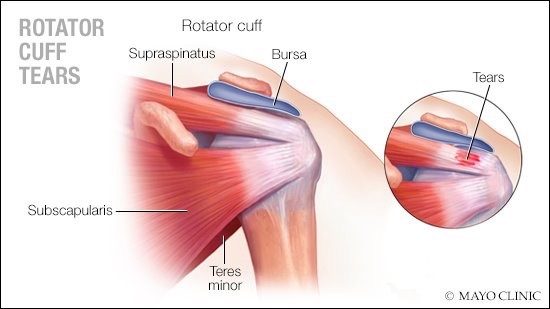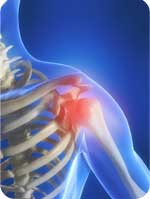Shoulder Pain
The shoulder joint is very mobile. It is a “ball and socket” joint surrounded by four muscles and their tendons called the rotator cuff. There are also large muscles like the deltoid, pectoralis major and trapezius, which surround the shoulder. The most common shoulder conditions are:
- Rotator cuff impingement (tendonitis and/or bursitis)
- Rotator cuff tear
- Frozen Shoulder
- Shoulder Separation
Rotator Cuff Injuries
Pain in the rotator cuff is often felt in the shoulder or down the arm. Overhead activities such as throwing, swimming, or repetitive lifting above shoulder height can lead to pain in the rotator cuff. If the space between the rotator cuff and bone above it is narrowed, either due to injury or the aging process, the rotator cuff tendons and the overlying bursa can become pinched and inflamed. This is called “impingement” and can lead to bursitis and/or tendonitis.
Sometimes a calcium deposit may form in the rotator cuff and cause inflammation of the tendon and bursa.
As we get older, the rotator cuff tendons weaken and can wear out; especially if there have been injuries in the past, or a history of wear and tear. A rotator cuff tear can occur due to the aging process alone, or repetitive strain or traumatic events, such as a fall on an outstretched hand or on the outside of the shoulder. A Physiotherapist will perform a number of tests on you to try and find out the exact cause of your rotator cuff pain.

Frozen Shoulder
Frozen shoulder, also known as adhesive capsulitis, is when you have pain and stiffness in your shoulder. It may not have any cause that you can recall. Frozen shoulder usually affects one shoulder, although some people may develop it in both. A Physiotherapist will instruct you in effective rehabilitation program to help aide in your recovery. Gentle to moderate mobilizations, self-management range of motion exercises, and encouragement to functionally use the arm, are likely the best interventions. Recovery can be between 1 and 2 years.
Separated Shoulder
A separated shoulder is a common injury among young athletes, but it can happen to anyone who falls and lands on the tip of their shoulder. The result can be partial or full tearing of the muscles, tendons, and ligament that hold the bones in your shoulder together. After such an injury, the arm is limp, it is difficult and painful to lift it, and there is a lot of pain in the shoulder. You will be advised to wear a sling for a short while after the injury, and your Physiotherapist will teach you exercises to increase your range of motion and strength.
Treatment
If you have had an injury and your shoulder pain is worsening you should see a Physiotherapist for diagnosis and treatment as soon as possible, as it will not likely resolve on its own. Your treatment will include pain relief, stretching exercises if needed, and strengthening. It is very important with all shoulder problems that the muscles around the shoulder be rehabilitated properly and fully, to ensure that every move you make is correct, and the injury is not going to continue causing problems. If conservative treatment (physiotherapy) is not successful, a consultation with an orthopedic specialist may be warranted to determine if surgical intervention is required.

